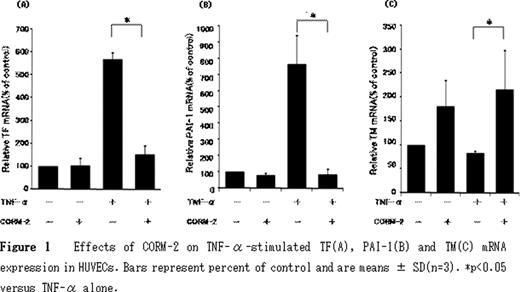Abstract
Abstract 1146
Heme oxygenase-1 (HO-1) is a cytoprotective and anti-inflammatory protein that catalyzes the conversion of heme into biliverdin, free iron, and carbon monoxide (CO). HO-1 is rapidly induced by various oxidative stresses and inflammation, thereby playing an important role in the self defence system. Recently, Yachie, et al. reported the first human case of HO-1 deficiency. This patient showed prominent signs of intravascular hemolysis, endothelial cell injury, and abnormalities in the coagulation / fibrinolysis system, suggesting the involvement of HO-1 or HO-1 products, such as CO, regulation of coagulation / fibrinolysis system. The current study examined whether tricarbonyldichlororuthenium (II) dimer (CORM-2), which liberated CO in the presence of dimethyl sulfoxide (DMSO), modulates the expression of tissue factor (TF), plasminogen activator inhibitor type 1 (PAI-1) and thrombomodulin (TM) in human umbilical vein endothelial cells (HUVECs).
HUVECs were pretreated with CORM-2 at the concentration of 50 μM for 3h, washed and stimulated with tumor necrosis factor-α(TNF-α, 10 ng/ml) for additional 2 or 5h. The mRNA and protein levels of TF, PAI-1 and TM in the cultured HUVECs were determined by real-time reverse transcriptase polymerase chain reaction and Western blotting. To determine whether CORM-2 affects the MAPK signaling pathways, the phosphorylation of p38 mitogen-activated protein kinase (p38MAPK) and extracellular signal-regulated kinase1/2 (ERK1/2) in the HUVECs were analyzed with Western blotting.
After TNF-α stimulation, TF mRNA levels were approximately 6-fold and PAI-1 mRNA levels were approximately 8-fold increased, and TM mRNA levels were decreased by 20% compared to the control. Similarly to the mRNA expression, TF and PAI-1 protein levels were increased while the TM protein level was decreased. On the other hand, pretreatment of HUVECs with CORM-2 significantly decreased TF mRNA levels (approximately 80% suppression), and PAI-1 mRNA levels (approximately 90% suppression) while increased TM mRNA levels by 3-fold as compared to the TNF-α-stimulated group (p<0.05; Figure 1). Similarly, the pretreatment with CORM-2 inhibited TNF-α-induced TF and PAI-1 protein up-regulation and TM protein down-regulation. CORM-2 inhibited TNF-α-induced activation of p38MAPK and ERK1/2 by 50% compared to the control.
These results indicate that CO liberated by CORM-2 suppresses the TNF-α-induced TF and PAI-1 up-regulation and prevents the TNF-α-induced TM down-regulation in HUVECs via MAPK signaling pathways. Thus, the modulation of endothelial function by CO may offer a novel antithrombotic option for treatment of the hypercoagulable state associated with inflammation.
No relevant conflicts of interest to declare.
Author notes
Asterisk with author names denotes non-ASH members.


This feature is available to Subscribers Only
Sign In or Create an Account Close Modal